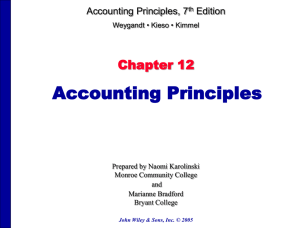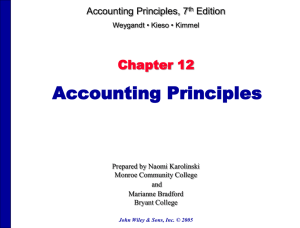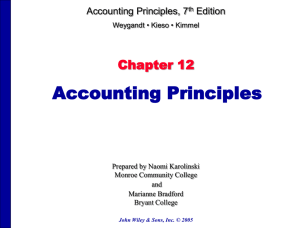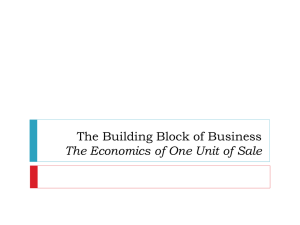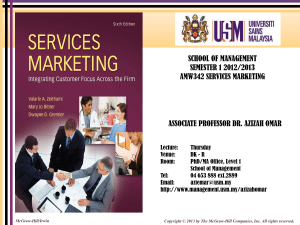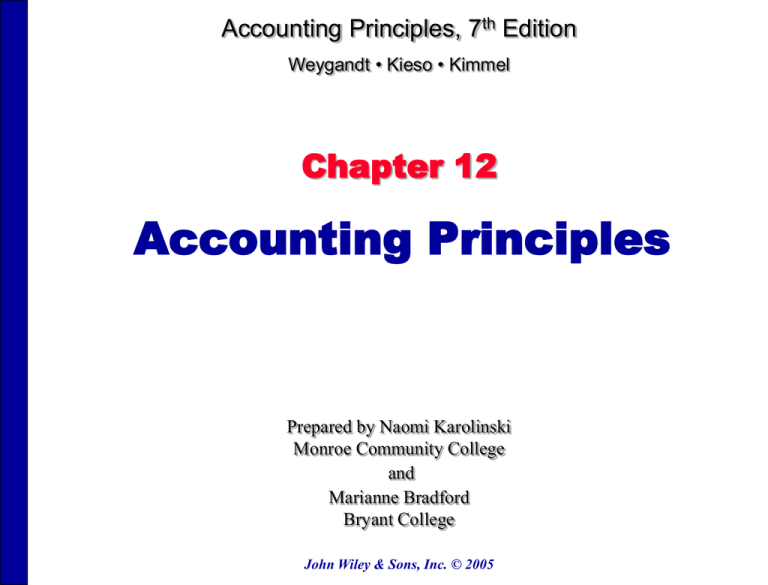
Accounting Principles, 7th Edition
Weygandt • Kieso • Kimmel
Chapter 12
Accounting Principles
Prepared by Naomi Karolinski
Monroe Community College
and
Marianne Bradford
Bryant College
John Wiley & Sons, Inc. © 2005
CHAPTER 12
ACCOUNTING PRINCIPLES
After studying this chapter, you should be able to:
1 Explain the meaning of generally accepted
accounting principles and identify the key
items of the conceptual framework.
2 Describe the basic objectives of financial
reporting.
3 Discuss the qualitative characteristics of
accounting information and elements of
financial statements.
CHAPTER 12
ACCOUNTING PRINCIPLES
After studying this chapter, you should be able to:
4 Identify the basic assumptions used by
accountants.
5 Identify the basic principles of accounting.
6 Identify the two constraints in accounting.
7 Explain the accounting principles used in
international operations.
CONCEPTUAL FRAMEWORK
OF ACCOUNTING
STUDY OBJECTIVE 1
• Generally accepted accounting principles
– set of standards and rules that are recognized as a general
guide for financial reporting
• Generally accepted
– means that these principles must have substantial
authoritative support
• Financial Accounting Standards Board (FASB)
and Securities and Exchange Commission
(SEC)
• The FASB has the responsibility for developing
accounting principles in the United States.
FASB’S CONCEPTUAL
FRAMEWORK
•
•
The conceptual framework developed by the
FASB serves as the basis for resolving accounting
and reporting problems.
The conceptual framework consists of:
1) objectives of financial reporting;
2) qualitative characteristics of
accounting information;
3) elements of financial statements; and
4) operating guidelines (assumptions,
principles, and constraints).
OBJECTIVES OF FINANCIAL
REPORTING
STUDY OBJECTIVE 2
FASB objectives of financial reporting are
to provide information that is:
1 useful to those making investment
and credit decisions
2 helps in assessing future cash flows
3 identifies the economic resources (assets),
the claims to those resources (liabilities),
and the changes in those resources and
claims
QUALITATIVE CHARACTERISTICS
OF ACCOUNTING INFORMATION
STUDY OBJECTIVE 3
To be useful, information should possess
the following qualitative characteristics:
1 relevance
2 reliability
3 comparability
4 consistency
RELEVANCE
• Accounting information has relevance if
it makes a difference in a decision.
• Relevant information helps users forecast
future events (predictive value),
or it confirms or corrects prior
expectations (feedback value).
• Information must be available
to decision makers before it
loses its capacity to influence
their decisions (timeliness).
RELIABILITY
•
•
Reliability of information means that the
information is free of error and bias, in
short, it can be depended on.
To be reliable, accounting information
must be verifiable.
COMPARABILITY AND
CONSISTENCY
•
•
Comparability means that the information should be
comparable with accounting information about other
enterprises.
Consistency means that the same accounting
principles and methods should be used from year to
year within a company.
2005
2006
2007
QUALITATIVE CHARACTERISTICS
OF ACCOUNTING INFORMATION
Useful
Financial
Information has:
Relevance
Reliability
1 Predictive value
1 Verifiable
2 Feedback value
2 Faithful representation
3 Timeliness
3 Neutral
Comparability
Consistency
CHARACTERISTICS OF USEFUL
INFORMATION
THE OPERATING GUIDELINES OF
ACCOUNTING
• Operating guidelines are classified as
assumptions, principles, and constraints.
• Assumptions provide a foundation for the accounting
process.
• Principles indicate how transactions and other economic
events should be recorded.
• Constraints on the accounting process allow for a relaxation
of the principles under certain circumstances.
Assumptions
Monetary unit
Economic entity
Time period
Going concern
Principles
Revenue recognition
Matching
Full disclosure
Cost
Constraints
Materiality
Conservatism
ASSUMPTIONS
USED IN ACCOUNTING
The primary criterion by which accounting
information can be judged is:
a. consistency.
b. predictive value.
c. decision-usefulness.
d. comparability.
The primary criterion by which accounting
information can be judged is:
a. consistency.
b. predictive value.
c. decision-usefulness.
d. comparability.
ASSUMPTIONS
STUDY OBJECTIVE 4
Monetary unit assumption:
– only transaction data expressed in terms of money can be
included in the accounting records
Example: employee satisfaction and percent of
international employees are not transactions that
should be included in the financial records.
Customer Satisfaction
Percentage of
International Employees
Should be included
in accounting records
Salaries paid
ECONOMIC ENTITY
ASSUMPTION
Activities of the entity kept separate
and distinct from the activities of the owner
and all other economic entities.
Example: BMW activities
can be distinguished from
those of other car
manufacturers such as Mercedes.
TIME PERIOD ASSUMPTION
Economic life of a business divided into
artificial time periods.
2005
QTR 1
QTR 2
QTR 3
QTR 4
2006
JAN
APR
JUL
OCT
FEB
MAY
AUG
NOV
2007
MAR
JUN
SEPT
DEC
GOING CONCERN
ASSUMPTION
Enterprise will continue in operation long
enough to carry out its existing objectives.
Implications: depreciation and amortization
are used, plant assets recorded at cost instead
of liquidation value, items are labeled as fixed
or long-term.
PRINCIPLES
REVENUE RECOGNITION
STUDY OBJECTIVE 5
•
•
Revenue recognition principle
dictates that revenue should be
recognized in the accounting
period in which it is earned.
When a sale is involved, revenue is
recognized at the point of sale.
PERCENTAGE-OF-COMPLETION
METHOD OF REVENUE
RECOGNITION
• In long-term construction contracts, revenue
recognition is usually required before the contract is
completed.
• The percentage-of-completion method recognizes
revenue on the basis of reasonable estimates of
progress toward completion.
• A project’s progress toward completion is
measured by comparing the costs incurred in a
year to total estimated costs of the entire
project.
FORMULA TO RECOGNIZE REVENUE IN THE
PERCENTAGE-OF-COMPLETION METHOD
Costs Incurred
(Current
Period)
Percent
Complete
(Current
Period)
÷
X
Total
Estimated
Cost
Total Revenue
=
=
Percent
Complete
(Current
Period)
Revenue
Recognized
(Current
Period)
FORMULA TO COMPUTE GROSS PROFIT
IN CURRENT PERIOD
The costs incurred in the current period are then
subtracted from the revenue recognized during the
current period to arrive at the gross profit.
Revenue
Recognized
(Current
Period)
X
Cost Incurred
(Current
Period)
=
Gross Profit
Recognized
(Current
Period)
REVENUE RECOGNIZED
PERCENTAGE-OF-COMPLETION METHOD
Warrior Construction Co. has a contract to build a dam for $400
million. It will take 3 years (starting in 2005) at a construction cost of
$360 million. Assume that Warrior incurs $54 million in 2005, $180
million in 2006, and $126 million in 2007 on the dam project. The
portion of the $400 million of revenue recognized in each of the 3
years is shown below:
Year
2005
2006
2007
Totals
Costs
Incurred
(Current
Period)
÷
$ 54,000,000
180,000,000
126,000,000
$ 360,000,000
Percent
Total
Complete
Estimated
(Current
Total
═ Period) X
═
Cost
Revenue
$ 360,000,000
15%
$ 400,000,000
360,000,000
50%
400,000,000
Balance required to complete the contract
Revenue
Recognized
(Current
Period)
$ 60,000,000
200,000,000
140,000,000
$ 400,000,000
GROSS PROFIT RECOGNIZED
PERCENTAGE-OF-COMPLETION METHOD
The gross profit recognized each period for Warrior Construction
Co. is as shown below. Use of the percentage-of-completion method
involves some subjectivity. As a result, errors are possible in
determining the amount of revenue recognized. To wait until
completion would seriously distort the financial statements. If it is
not possible to obtain dependable estimates of costs and progress,
then the revenue should be recognized at the completion date and not
by the percentage-of-completion method.
Year
2005
2006
2007
Totals
Revenue
Recognized
(Current
Period)
$ 60,000,000
200,000,000
140,000,000
$ 400,000,000
–
Actual Cost
Incurred
(Current
═
Period)
$ 54,000,000
180,000,000
126,000,000
$ 360,000,000
Gross Profit
Recognized
(Current
Period)
$ 6,000,000
20,000,000
14,000,000
$ 40,000,000
GROSS PROFIT FORMULA
INSTALLMENT METHOD
• Under installment method, each cash collection
from a customer consists of
1) a partial recovery of the cost of goods sold and
2) partial gross profit from the sale.
• The formula to recognize gross profit is shown
below.
Cash
Collections from
Customers
x
Gross Profit
Percentage
=
Gross Profit
Recognized
during the
Period
GROSS PROFIT RECOGNIZED
INSTALLMENT METHOD
An Iowa farm machinery dealer had installment sales in its first year of
operations of $600,000 and a cost of goods sold on installment of $420,000.
Therefore, total gross profit is $180,000 ($600,000 - $420,000), and the gross
profit percentage is 30% ($180,000 ÷ $600,000). The collections on the
installment sales were: First year, $280,000 (down payments plus monthly
payments), second year, $200,000, and third year, $120,000. The collections
of cash and recognition of the gross profit are summarized below (ignoring
interest charges).
Year
2005
2006
2007
Totals
Cash
Collected
$ 280,000
200,000
120,000
$ 600,000
X
Gross Profit
Percentage
30%
30%
30%
=
Gross Profit
Recognized
$ 84,000
60,000
36,000
$ 180,000
MATCHING
(EXPENSE RECOGNITION)
Expense recognition is traditionally
tied to revenue recognition.
• referred to as the matching
principle
• dictates that expenses be matched
with revenues in the period in which
efforts are made to generate
revenues.
MATCHING (EXPENSE RECOGNITION)
PRINCIPLE
Unexpired costs become expenses in two ways:
1) Cost of goods
merchandise inventory becomes expensed when
the inventory is sold
2) Operating expenses
other unexpired costs through use or
consumption or through the passage of time
EXPENSE RECOGNITION
PATTERN
Operating expenses contribute to the revenues
of the period but their association with revenues
is less direct than for cost of goods sold.
Provides Future
Benefit
Cost
Incurred
Provides No
Apparent Future
Benefits
Benefits Decrease
Asset
Expense
FULL DISCLOSURE
PRINCIPLE
• Requires that circumstances and events that
make a difference to financial statement users
be disclosed.
• Compliance with the full disclosure principle
1) data in the financial statements
2) notes that accompanying the statements
• Summary of significant accounting policies
usually the first note to the financial
statements
COST PRINCIPLE
• The cost principle dictates that assets be
recorded at their cost.
• Cost is used because it is both relevant and
reliable.
1) Cost is relevant because it represents a) the
price paid, b) the assets sacrificed, or c) the
commitment made at the date of
acquisition.
2) Cost is reliable because it is a) objectively
measurable, b) factual, and c) verifiable.
BASIC PRINCIPLES USED IN
ACCOUNTING
CONSTRAINTS IN ACCOUNTING
STUDY OBJECTIVE 6
Two constraints
• Materiality
– relates to an item’s impact on a firm’s overall
financial condition and operations.
• Conservatism
– dictates that when in doubt, choose the method that
will be the least likely to overstate assets and income
CONSTRAINTS IN
ACCOUNTING
CONCEPTUAL FRAMEWORK
Objectives of Financial Reporting
Qualitative
Characteristics of
Accounting Information
Elements of
Financial Statements
Operating Guidelines
Assumptions
Principles
FOREIGN SALES AND TYPE OF
PRODUCT
STUDY OBJECTIVE 7
• World markets are becoming increasingly
intertwined, and foreigners consume American
goods.
• Americans use goods from many other countries.
• Firms that conduct operations in more than one
country through subsidiaries, divisions, or
branches in foreign countries are referred to as
multinational corporations.
• International transactions must be translated into
U.S. dollars.
The organization that issues international
accounting standards is the:
a.
b.
c.
d.
Financial Accounting Standards Board
International Accounting Standards Board.
International Auditing Standards Committee.
None of the above.
The organization that issues international
accounting standards is the:
a.
b.
c.
d.
Financial Accounting Standards Board
International Accounting Standards Board.
International Auditing Standards Committee.
None of the above.
CHAPTER 12
ACCOUNTING PRINCIPLES
Copyright © 2005 John Wiley & Sons, Inc. All rights reserved. Reproduction or
translation of this work beyond that permitted in Section 117 of the 1976 United
States Copyright Act without the express written consent of the copyright owner is
unlawful. Request for further information should be addressed to the Permissions
Department, John Wiley & Sons, Inc. The purchaser may make back-up copies for
his/her own use only and not for distribution or resale. The Publisher assumes no
responsibility for errors, omissions, or damages, caused by the use of these
programs or from the use of the information contained herein.

